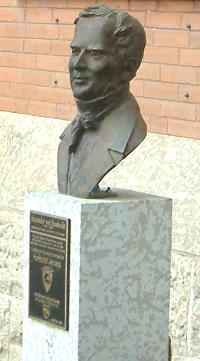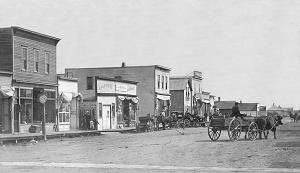
The name "Humboldt" was approved in 1875 for a site in the North West Territories along the Canadian Pacific Telegraph Line. The line was part of the original Dominion Telegraph Line of 1876 to eastern Canada via Fort Pelly / Swan River. The Humboldt Telegraph Station was built in 1878 by lineman George Weldon eight kilometers southwest of the present city. George’s wife Catherine was one of the first female telegraph operators in western Canada. The station was located alongside the prominent Carlton Trail which branched west to Clark’s Crossing or north to Batoche. The Humboldt Telegraph Station played a pivotal role in the 1885 Uprising of Louis Riel and the Metis. General Middleton and his troops stopped at Humboldt in April 1885, after marching from Fort Qu'Appelle, en route to Batoche. Colonel Denison and his troops arrived at the Humboldt Telegraph Station on May 1, 1885. Denison fortified the site by digging an extensive series of trenches that his troops called "Fort Denison." With the battle raging between the Metis and the Dominion Government, Denison notes that "Humboldt became the end of the telegraph line." The line further west was routinely cut to hamper communications. Humboldt became an important communication link and military site for Prime Minister John A. Macdonald and his forces in the west. By the early 1900s, settlers were arriving in the area and the name Humboldt was transferred to the emerging settlement. The name honoured Baron Alexander von Humboldt, born in Prussia in 1769. Humboldt was a famous scientist, explorer and author whose work in South and Central America influenced Charles Darwin. By 1903, the establishment of St. Peter’s Colony by the Benedictine monks and the marketing by the German American Land Company attracted many settlers to homestead in the area, including numerous German Catholics from the United States. The Canadian Northern railway arrived in September 1904, providing an essential transportation route to the new community. In May 1905, the first passenger train arrived and the district flourished. In June 1905, the village of Humboldt was incorporated. The community continued to grow to over 400 people, thus becoming a town on April 1, 1907. On November 7, 2020 Humboldt was declared Saskatchewan's thirteenth city. For more information about Humboldt's interesting history, please click here to visit the Humboldt & District Museum & Gallery website. Humboldt History Book Best Of Humboldt – Centennial Edition (Including Burr, Carmel, Fulda and Marysburg) is the culmination of about two years of research and writing by a dedicated committee of about 27 people. The book was printed at St. Peter's Press in Muenster, SK in June of 2006. (Photo at right: Main street, Humboldt, about 1910) It is a large book, about 880 pages, and includes more than 1,300 photographs, which are a combination of family pictures and historic pictures of Humboldt and district. The book describes the history of Humboldt and district, in word and pictures, from when it first began to the present day. This book will be of special interest to people who were born here, lived here or had early ancestors who were raised here. To purchase this book, please click here. | 



